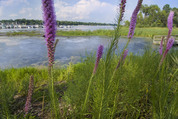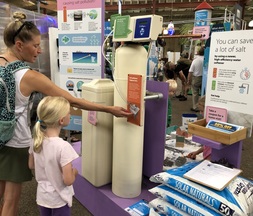|
Cities and other government entities can borrow up to $20 million with 0% interest to address non-point source pollution through the Clean Water Partnership program.
Eligible projects include:

-
Urban green infrastructure such as rain water reuse, green roofs, porous pavement, or any stormwater best management practice (BMP)
-
Buffers: purchase of native seeds and vegetation
-
Septic system upgrades and replacements
- Technical assistance, outreach, and education
-
Equipment such as conservation tillage equipment
-
Any nonpoint source BMP
-
Feedlot upgrades and replacement
Project sponsors can use the loans to implement projects directly or to set up a loan fund for landowners and other stakeholders. Government entities may apply to the Minnesota Pollution Control Agency (MPCA) at any time.
See the program webpage for more information, or contact:
|
 What do corn dogs and water softener settings have in common? You will find both at the Minnesota State Fair this year. One of the water exhibits at Eco Experience focuses on how people can set their water softeners to use less water and less salt, meaning less chloride passing through wastewater treatment facilities to lakes and streams.
Eco Experience is a building filled with hands-on activities, demonstrations and resources, open daily at the State Fair through Sept. 3 from 9 a.m. – 9 p.m.
Other water exhibits this year include:
- A “sink slide,” where children and adults can learn why it is important to keep things like pharmaceuticals, household hazardous waste, dyes, fragrances, and microbeads out of the drain.
- A close look at bugs that live in lakes and streams and what they can tell us about the health of Minnesota waters.
- A visual display by Great Lakes Aquarium about how climate change can affect Lake Superior.
- Recommendations for maintaining septic systems.
- Twin Cities residents can sign up to adopt a storm drain.
Also popular at Eco Experience is the Water Bar, where fair-goers can taste water from around Minnesota.
A partnership between the Minnesota State Fair, the MPCA, and more than 150 organizations and businesses across the state, the Eco Experience has become the second most visited exhibit at the fair. The Eco Experience is the largest environmental event of its kind, nationally, in the last two decades. Since 2006, more than 3.5 million visitors have attended the 25,000-square-foot exhibit to learn more about clean air and water, saving energy, climate change, recycling, healthy local food, gardening, transportation, green building and remodeling, and other ways to lead more eco-friendly lives.
Related media coverage:
|

Implementing
voluntary land use management practices would reduce water pollution in the Lower
Red River Watershed according to two draft studies by the Minnesota Pollution
Control Agency (MPCA) and local watershed partners. The MPCA invites comments
on the studies through Sept. 12.
Local partners
include the Kittson, Marshall, and Roseau Soil and Water Conservation Districts
and the Two Rivers, Joe River, and Middle-Snake-Tamarac Rivers Watershed
Districts.
Excessive levels
of bacteria, sediment, a pesticide called chlorpyrifos, and chloride, along
with stressors causing poor fish and aquatic insect communities, contribute to
impairments in this northwest Minnesota watershed. The stressors that
negatively impact some fish and aquatic insect communities include barriers to
fish passage, altered stream flows, lack of physical habitat, high levels of
suspended sediment, and low dissolved oxygen.
The reports also
recommend implementation of practices to protect waters currently in good
condition.
People have made
extensive changes to promote water drainage in order to facilitate crop
production. These changes include straightening streams and installing drainage
ditches. The changes have also resulted in negative impacts to water quality,
stream habitat, and fish and aquatic insect communities. Water-based
recreation is impaired at times by excessive bacteria levels.
To bring about
significant water quality improvement, the studies recommend widespread changes
in land use and agricultural practices. These voluntary actions, coupled with
increased public understanding and support, need to occur because the vast
majority of land is privately owned and used for agriculture. While landowners
in the Lower Red River Watershed have long been engaged in good land
stewardship practices, the MPCA and its partners recommend they continue to
build upon best management practices known to improve water quality.
Open for comment
are the Total Maximum Daily Load (TMDL) study and the Watershed Restoration and
Protection Strategies (WRAPS) report. They are companion documents that
quantify pollutant levels, identify pollution sources, propose ways to return
water quality to an acceptable level and describe protection strategies to ensure
continued high quality water resources.
The draft Lower
Red River of the North TMDL and WRAPS reports recommend restoring stream
reaches to more natural meandering; creating water impoundments, which can
reduce flooding, support stream flow, and improve water quality; taking highly
erodible areas out of production; and adding buffers, cover crops and perennial
vegetation.
Comments on the
draft reports should be sent to Danielle Kvasager, 714 Lake Avenue, Suite 220,
Detroit Lakes, Minnesota 56501; or by email, danielle.kvasager@state.mn.us.
For more information, call her at 218-846-8117. Comments must be received by
4:30 p.m. on Sept. 12.
Written comments must
include a statement of your interest in the report (specify which report, WRAPS
or TMDL), a statement of the action you wish the MPCA to take, including
specific references to sections of the draft report you believe should be
changed, and specific reasons for your position.
|
 If a lake draw-down project works as intended, Diamond Lake in Kandiyohi County east of Willmar could see a return of some water quality lustre. Instead of draining nutrient-rich water into Diamond Lake, a chain of three nearby shallow lakes will have a draw-down intended to improve their water quality and habitat, and flow reversed away from Diamond. While less than half of Diamond Lake's watershed, the three nearby lakes contribute about 75 percent of the phosphorus load to Diamond.
On Aug. 22 state and local partners behind the project and guests toured the Hubbard, Wheeler, and Schultz lakes management project. It started in 2010 with Ducks Unlimited and Middle Fork Crow River Watershed District. Working with the DNR and local landowners, the project received Outdoor Heritage Funds complemented by funds from the MFCRWD and DU. Three water control structures are installed between the lakes, and a large subsurface pipe provides outflow. Total cost was nearly $800,000. The lakes are expected to reach full draw-down this winter. It will help remove rough fish and improve aquatic plants. Natural recharge will begin next spring. According to the DNR it is the first draw-down project to involve a chain of lakes. Photo: Tour members peer down the access to the subsurface pipe where flow from the three lakes enters a county ditch.
|
The third annual "Secchi Social" for citizen water quality monitors will be Thursday, Sept. 27 at Chase on the Lake, Walker. The event gathers volunteer monitors to network and hear presentations by local water resource professionals about water quality protection efforts in the region. Citizen Monitoring Program volunteers will share their thoughts and perspectives on monitoring. Volunteer speakers are encouraged to contact the MPCA. There will be recognition of five-year “Milestone” volunteers in attendance, raffle prizes, and a catered lunch. Coffee and registration 10-11 a.m., lunch and program 11 a.m.-2 p.m. A block of rooms has been reserved for the night of Sept. 26. An online RSVP form is due Friday, Sept. 14, or call Laurie Sovell at 651-757-2750 or Shannon Martin at 651-757-2874 with your attendance information. There is no cost, and each volunteer can have one additional guest attend. You only need to RSVP if you plan on attending.
- Sept 12: Minnesota Erosion Control Assoc. tour of the St. Anthony Falls Laboratory, an interdisciplinary fluid mechanics research and educational facility on Hennepin Island in Minneapolis. Email meca@mnerosion.org for details.
- Sept. 15: 10th Annual Cannon River Watershed-Wide Cleanup, 9 a.m.-noon in Northfield (two sites), Faribault, Owatonna, Cannon Falls, Shields Lake, Waterville, Welch, Medford and Red Wing. For more information, visit www.crwp.net/cleanup.
- Sept. 15: Crow River cleanup, Crow River Organization of Water, Buffalo.
- Sept. 20: Minnesota Erosion Control Assoc. field seminar, New Tech High School, St. Cloud.
- Sept. 20: Friends of the Mississippi hold “An Evening Celebrating the Mississippi River," Minneapolis.
- Oct. 2-3: Nobel Conference: Living soil - a universe underfoot, Gustavus Adolphus College, St. Peter.
- Oct. 16-17: Minnesota Water Resources conference, St. Paul RiverCentre.
- Oct. 29-31: BWSR Academy, Breezy Point Conference Center, Brainerd.
- Nov. 8: Minnesota River Congress, Jackpot Junction (scheduling in process), Morton.
|